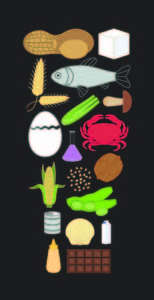Trending
Food Allergies: Living with Food Allergies & Sensitivities
By Lucy Haines
September, 2017

Most people can eat a peanut butter sandwich or drink a glass of milk without a thought. But for those with food allergies or sensitivities, every bite taken requires awareness and vigilance. While for some, the restriction or elimination of certain foods (going dairy-free, for example) is a lifestyle choice, for others, it’s a critical health matter. So what exactly is the difference between a food allergy and a food sensitivity, and how can people with such issues eat safely at home, work or school?
Allergy, Sensitivity, or Lifestyle Choice
True food allergies are a growing public health issue in Canada, affecting as many as six percent of children (some 300,000 of which are younger than 18) and three to four percent of adults, according to Food Allergy Canada. While food sensitivity (an adverse reaction to a food that other people can safely eat) is an umbrella term encompassing food allergies, intolerances and chemical sensitivities, allergies are the most dangerous.
A food allergy is triggered when a person’s immune system responds to a food protein, resulting in a histamine response that can affect his or her respiratory system, gastrointestinal tract and/or cardiovascular system. A food intolerance (such as lactose intolerance) doesn’t involve the immune system, so a person can often tolerate a small amount of such foods before having a negative reaction. Signs of lactose intolerance, usually occurring within two hours of consuming milk-based products, can include abdominal bloating, pain or cramping, diarrhea, gas or nausea/vomiting.
As for chemical sensitivities, they occur when a person reacts to natural or added chemicals in foods (such as sulphite preservatives, MSG or caffeine).
Registered dietician Wendy Busse, creator of FoodAllergyNews.com, works with Alberta clients to expand their diets when food allergies or sensitivities reduce what foods they can safely eat. She says that while some may choose to go gluten-free or without dairy in hopes of losing weight or because they “feel better” when they don’t eat certain foods, malnutrition and health safety are priority concerns for those with true allergies and intolerances.
“With any allergy, the biggest concern is anaphylaxis, a severe, rapid onset reaction that can cause death,” says Busse. “There is no cure for food allergies, though some can be outgrown and some can develop later in life. The only way to prevent a reaction is avoidance of the allergenic foods.”
Of School Lunches & Epi-pens
Those with life-threatening allergies usually carry epinephrine auto-injectors such as Epi-Pen or Allerject. The mantra “blue to the sky, orange to the thigh” is well known by school children, parents and educators who are prepared in case students have a severe reaction to the most common allergens—nuts, dairy or wheat. In St. Albert schools, staff are advised of any known life-threatening allergies (through a health questionnaire at registration) so that trained staff can respond if there’s ever an allergic reaction. Rhonda Nixon, assistant superintendent of learning services with Greater St. Albert Catholic Schools, says a safety team in every school is prepared to administer Epi-pens, medication and decipher food labels for students that they know are allergic to specific foods.
“There’s a much greater awareness even from five years ago, about foods that are acceptable in school lunches and how to avoid cross-contamination” Nixon says. “And the Epi-pen is a tool that can buy time until one gets medical attention.
Living with Lactose
Lactose intolerance/allergies often manifest with painful gut/bowel issues following eating the offending milk, cheese, ice cream or other dairy product. Under a doctor’s or dietician’s supervision, people can eliminate an offending food for a time and re-introduce it slowly in small amounts to see if any can be tolerated.
Emily Mardell, registered dietician with the St. Albert and Sturgeon Primary Care Network, recommends a small amount of lactose to help encourage digestive tolerance through small and regular exposure. Low lactose options such as cheddar cheese or Greek yogurt are a good place to start, she says.
“Plant-based beverages such as almond, cashew or coconut may also be good substitutes. However, these are often lower in protein and other nutrients so be sure to read labels,” says Mardell. “For individuals with milk allergy and no dairy intake, it’s a good idea to choose other foods, or supplements that provide calcium and vitamin D.”
Gluten Be Gone
Celiac disease is an allergy to wheat/gluten, which damages the small intestine, causing pain and discomfort and hampering the absorption of nutrients. Brian Readman, Edmonton chapter president of the Canadian Celiac Association, says about 1 in 100 Canadians is celiac, with 7 in 100 gluten-intolerant. “There are 200 possible symptoms, including diarrhea, constipation and gut pain,” he says.
Mardell recommends a gluten-free diet be supplemented with beans, peas, lentils and chickpeas.
“Pulses can boost the nutritional quality of gluten-free foods, too. They are rich in fibre, protein, folate and iron—all important nutrients when eating gluten-free,” she says “It can be a grieving process when people have to give up the foods they love, but the plethora of grocery store substitutes and restaurant products that are gluten, dairy or nut free makes it easier,” adds Busse.
Nut-free Nation
Peanut allergies affect about 2 in 100 children in Canada, making daycare centres, schools and homes routinely nut-free environments.
“Nut allergies can be one of the scariest of allergies. Especially if an individual is anaphylactic to nuts, then exposure is a life and death situation,” Mardell says.
If an individual can tolerate seeds, dieticians suggest including them as a source of essential fats, magnesium, and zinc. Pumpkin seeds, hemp seeds, chia seeds, flaxseeds and sunflower seeds are excellent options. Try a pumpkin-seed butter or other non-peanut butters on the market, say dieticians.
Resources are many for those with food allergies. While food labels are required to list any trace of priority allergens, sufferers must be ever-aware when it comes to avoiding exposure at restaurants, home and the workplace. Keeping cooking tools and utensils separate at home, and asking questions about food preparation when dining out requires ongoing vigilance. Resources such as Food Allergy Canada are also a good go-to for the latest on allergy information and advice. A doctor’s supervision is essential for treating the life-threatening reality of food allergies, but the marketplace and a better-informed public make living with food sensitivities more manageable than ever before. t8n
Birthday Cakes & Kids’ Parties
Children’s get-togethers are increasingly nut-free these days, but lactose and glucose allergies can leave a lot of kids feeling left out (and their parents stressed out). To ensure that everyone can have a fun and safe day, opt for a nut-free, gluten-free, vegan cake from a bakery you trust. The abundance of gluten-free flour substitutes also means a home-baked cake is an option. As for the ice cream, look for lactose-free options at the grocery store. They are, thankfully, becoming less difficult to find.
Did You Know?
The most common food allergies include peanuts,
tree nuts, sesame seeds, wheat, eggs, milk, soy, mustard and seafood. While a person can be allergic to any food, the Government of Canada deems these as priority allergens for food labelling purposes.
- allergies
- allergy
- beverages
- dairy
- drinks
- food
- intolerances
- nausea
- nuts
- pain
- school
- sensitive
- sensitivity
- vomiting
- wheat











